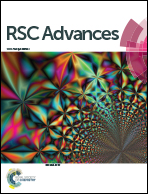3D printed MOF-based mixed matrix thin-film composite membranes†
Abstract
MOF-based mixed-matrix membranes (MMMs) have attracted considerable attention due to their tremendous separation performance and facile processability. In large-scale applications such as CO2 separation from flue gas, it is necessary to have high gas permeance, which can be achieved using thin membranes. However, there are only a handful of MOF MMMs that are fabricated in the form of thin-film composite (TFC) membranes. We propose herein the fabrication of robust thin-film composite mixed-matrix membranes (TFC MMMs) using a three dimensional (3D) printing technique with a thickness of 2–3 μm. We systematically studied the effect of casting concentration and number of electrospray cycles on membrane thickness and CO2 separation performance. Using a low concentration of polymer of intrinsic microporosity (PIM-1) or PIM-1/HKUST-1 solution (0.1 wt%) leads to TFC membranes with a thickness of less than 500 nm, but the fabricated membranes showed poor CO2/N2 selectivity, which could be attributed to microscopic defects. To avoid these microscale defects, we increased the concentration of the casting solution to 0.5 wt% resulting in TFC MMMs with a thickness of 2–3 μm which showed three times higher CO2 permeance than the neat PIM-1 membrane. These membranes represent the first examples of 3D printed TFC MMMs using the electrospray printing technique.

- This article is part of the themed collection: Metal-organic frameworks and their applications


 Please wait while we load your content...
Please wait while we load your content...